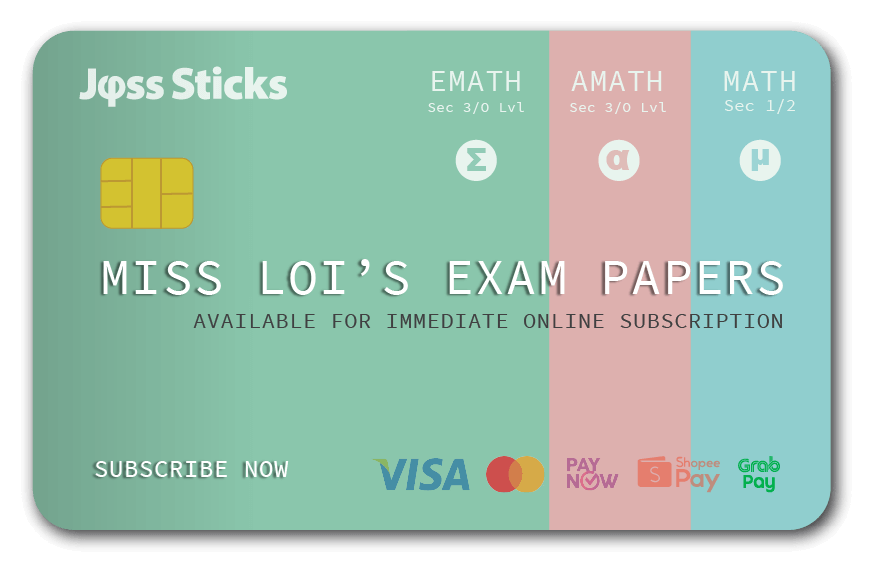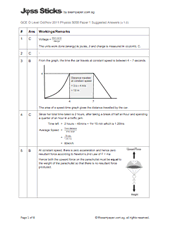Hello again everyone,
After having taken possession a certain booklet, I’m sitting in my sister’s car, looking up at the bright blue morning sky, while sending out this series of codes:
| Q1-10 | CCBCB AACCB |
| Q11-20 | DCBDB CBADA |
| Q21-30 | ACABC BCBAB |
| Q31-40 | DCBDA BDDAD |
Note: Answer for Q33 has been changed to B. Sorry for the misinformation! 🙁
Do they tally with yours?
Update: The list of workings and explanations for each of the answers (where applicable) have been compiled (along with the questions at the end)!
You may access here by clicking the ![]() button (if you haven’t yet done so).
button (if you haven’t yet done so).
Hopefully this will help in some way to settle some of the debates regarding some of the answers (and hopefully not create more in the process!)
Good luck for those of you with your remaining Science MCQ papers! ALMOST THERE!!!





 Miss Loi is a full-time private tutor in Singapore specializing in O-Level Maths tuition. Her life’s calling is to eradicate the terrifying LMBFH Syndrome off the face of this planet. For over years she has been a savior to countless students …
Miss Loi is a full-time private tutor in Singapore specializing in O-Level Maths tuition. Her life’s calling is to eradicate the terrifying LMBFH Syndrome off the face of this planet. For over years she has been a savior to countless students … 





















84 Comments
曜
日
for ques 11, I thought that the answer should be B? cuz only a stretched spring will have elastic potential energy... so at Q is potential and at P is kinetic?
曜
日
@YQ: P is the highest point of the oscillation, that is where the mass stops, and does a U-turn ... if that's the case the mass cannot have kinetic energy at that point, instead it has gravitational POTENTIAL energy :o)
曜
日
@Little Miss Loi: Its okay. I get it alr(:
曜
日
@Little Miss Loi: Thanks(:
曜
日
Hello. Thank you for providing answers(: However, I thought for question 6, the answer should be A? Only when all the arrows point in one direction, there will be no resultant force. As the nail does not move, so, that means there is no resultant force, right? (:
曜
日
@Wong Xin Hui: Oops Q6 should be A (just changed it)!
曜
日
Why is Q6 D? Shouldn't it be A? Since the nail does not move.
曜
日
@HP: Yup yup yup just changed it - got spooked!
曜
日
Hi miss Loi. Question 37 should be D.
曜
日
Can you relook Q30? I thought current passes through only one resistor. And also for Q37, cos I still get answer D.
曜
日
@Rachel: For Q30, answer is B as the current comes out from the alternating current supply, it can go through all four resistors if it travels in the clockwise direction, but when in the anti-clockwise direction the current cannot pass through the resistors which are along the same route as the diode.
Hence only 2 resistors carry the current in 2 directions, and the resistors adjacent to the diode carry current in ONE direction only
As for Q37, the answer is amended to D - thanks for highlighting!
*drawing a diagram to illustrate now*
...
曜
日
Thanks for the answers!
For qn37, I calculated the voltage and got D as my answer. How to calculate the voltage for qn37?
曜
日
@fb: A lot of people may think that B is the answer (which I did the same as well!!) in order to achieve a higher potential on the first transformer's output.
Here's the diagram for Q37 which I hope will be sufficient to illustrate how the voltages at various stages are obtained:
曜
日
Can you explain why qn36 is B?
曜
日
@fb: Induced emf is produced when a conductor (wire) experiences a rate of change of magnetic flux linkage (Faraday's Law).
In layman terms, the wire will only have emf if it "feels" a changing magnetic field.
At P and Q, the magnet "stops" to make a U-turn. This means when stationary, it experiences no change in magnetic field, hence no emf.
曜
日
hi:) thx for the ans but i i ask why qn 37 is b instead of d??
曜
日
@hi: See this diagram?
曜
日
Can someone do an explanation for 37?
Using Np/Ns = Vp/Vs, my best guess is B
Vp/Vs = 12V/6V = 2
So... Np/Ns must be 1000/500 = 2
~
曜
日
@Jay: Alright, I understand now. Thanks 🙂
曜
日
should question 33 be B?
When a person touches the live wire the fuse will not blow as a person has a very high resistant. Hence, the current flowing should be low.
曜
日
@hy: Yup amended to B. Thanks!
曜
日
is this same as 5057 paper?
曜
日
if the answers here are right, my mark should be 37/40 which should be alright. I have a question though. For question 39, my friends say the answer is option B but i wrote option D which tallies with your answer. Can you explain question 39? I don't really understand. And for question 36, why is the answer B? Please enlighten me. THANKS!
曜
日
@anonymous: sorry i post wrongly. My answer for question 39 is A and not D which tallies with your answer.
曜
日
@anonymous: Regarding Q36, be enlightened here.
曜
日
@Little Miss Loi: what about question 39? Thanks for explaining q 36. why is question 39 A and not B?
曜
日
@anonymous: For Q39, see a thermistor's resistance-temperature relationship here.
曜
日
For question 23, answer is A because the ray bends inwards aft passing through the lens?
曜
日
@IP: Actually no - more that the rays need to connect through the focal length and image and the object in a straight line. The diagram in A fits the model of a ray diagram for a magnifying glass image from a converging lens, hence it is a converging lens.
But well at least you chose A in the end - you got the mark and now let's learn from this! 😉
曜
日
@IP: Hi Ms Loi, can you please relook the answer for Q3. My answer was (C) 16m. There are two parts of the graph where the trolley was moving with constant speed, and the total distance travelled is (7-4)(4)+(1/2)(9-7)(4)=16, isn't it?
曜
日
@Claudia Tan: Errr ... the trolley cannot be travelling at constant speed at the '(1/2)(9-7)(4)' part since its speed clearly decreases from 4 m/s to 0 m/s from the 7th to the 9th second. This is constant deceleration!
曜
日
Can you relook qn 33? Isn't it A?
曜
日
@Jeffrey Lim: Should be B not A. Read this.
曜
日
why is the answer for qn 23 A instead of C?
曜
日
@ces: For Q23, does the following diagrams for options A & C ring a bell? *ting*
曜
日
Hi Miss Loi. For question 38, why will the brightness of L1 remain the same(option D)? Since current flowing through L1 decreases when the resistance of the LDR decreases.
曜
日
@Hazle: The brightness of the lamp is dependent on the potential difference across the lamp, which is held constant by the battery connected in parallel to it.
Though the resistance is changed in the circuit, the current flowing though the resistors also changes, so it's a better gauge to look at p.d instead of current.
曜
日
@Little Miss Loi: Ok thanks a lot =)
曜
日
@Little Miss Loi: SQhi objects!
Just so you, know, guys, I took the same paper =)
IMHO, the brightness of the bulb should be dependent on the power output of the bulb, and we know that P=IV
I assume everyone has a copy of the paper here.
Let's call the branch on the left with L1 Branch A, and the branch on the right with resistor R & L2, Branch B.
Miss Loi, as you have stated, since Branch A and Branch B are parallel, they would have the same pd as the emf of the battery remains unchanged.
Hence, the decisive factor should be current instead.
Now, as light intensity increases, resistance of R decreases, thus, the overall resistance of the circuit decreases. The resistance of Branch B also decreases, and the current flowing through Branch B increases.
Hence, as Branch B draws a greater current, the current Branch A draws decreases. Hence, by P=IV, the brightness of bulb L1 would decrease.
Oh well, one more bio and one more literature paper to go. JY everyone!!!
P.S.:
If you wonder why the brightness of L2 decreases, as resistance of R decreases, the pd across r
decreases(Little Miss Loi edit: you mean increases?) hence pd across L2 increases, leading to higher power output. It's kind of "common-sensical" anyway=)曜
日
@SQhi: Little Miss Loi objects!!!!!
Yes, as SQhi has said, the brightness of the bulb ultimately depends on its power which in turn is dependent on the current flowing through it.
This is true BUT this reduced overall resistance will also lead to an INCREASE in the overall current drawn by the circuit.
Yes Branch B will definitely draw a greater current due to the reduced resistance of R, so L2 will increase in brightness.
However, Branch A's current will remain the same given that 1) its pd is unchanged 2) the resistance of L1 is unchanged. So by Ohm's Law, the current through Branch A remains unchanged as well.
I've taken the liberty to sub in some arbitrary p. d. and resistance values just to demonstrate this. As you will see, Branch A's current stays constant due to the increased overall current drawn by the circuit, even though Branch B's current has increased.
In short, Ohm's Law will always sort itself out 😉
P.S. This reminds me to update the pdf file - there's a typo for the answer to Q38!
曜
日
@Little Miss Loi: Opps, typo in my post-note, sorry!(thanks for the correction!)
Anyway ya, that was for other visitors, not you =)
D= I have never considered Q38 from that angle...
D= My O level physics is in jeopardy!!! Serious, nerve-wracking jeopardy...
Yet, it feels so good to finally understand this, coz i expect myself to...
Anyway could you let me know how to type subscript and superscript in these comments, and how I could edit my own posts?
曜
日
i believe qn 22 and 23 are wrong. qn22 shld be B since is sin (air) / sin ( glass) =1.5 and qn we shld be C since its converging lens while the other 3 options are all diverging lens
曜
日
@Zhi Jie: For Q22, it is correct to say that the angle of refraction in glass is 28.1° as you've mentioned.
However, the question asks for how many degrees does the light ray change direction.
Therefore, change in direction = 45° − 28° = 17°
For Q23, see the diagrams I've painstakenly drawn 🙂
曜
日
Hais, why the questions so tricky one..
曜
日
Shouldn't the last question answer be 'C' because they are asking you about the frequency of the input of the cro, so it should be only about the screen and not counting the number of waves.
曜
日
@Jolene Lim: But in Q40, the screen displays two complete waveforms.
Since frequency is the inverse of the period of the wave, and the period of the wave is the time taken for ONE wave, the period is 1/400 ÷ 2 = 1/800 s.
Hence the frequency is (1/800)-1 which is 800 Hz.
曜
日
why is q23 B?
曜
日
@fb: the answer for question 23 should be B
曜
日
@mmmmmm: As shown below, option B shows the classic effect of parallel light rays passing through a diverging lens!
See the ray diagrams for A & C for why A (the magnifying glass) is the only converging lens.
曜
日
hi so qn 37 is D right?
曜
日
@anon: Yup yup yup yup yup
曜
日
HI... can u explain to me why the ans for qn 33 is C? thks:)
曜
日
@Ian Pang: B! B! B!
曜
日
ARGH.. i feel very extremely stupid after looking at this.. and how come everyone's so smart...
曜
日
qn11: my ans was C---becos when u move down spring, elastic potential stored at Q. When u release it is converted to kinetic energy, so at P gt kinetic energy.
曜
日
@Dannie: As mentioned previously, there's no kinetic energy at P because M stops here momentarily before continuing in the opposite direction i.e. making a U-turn.
曜
日
for qn 26, i got D as answer.
becos Npole created in left of solenoid and south pole at right side.
so, poles induced in rods should be opoosite to poles in solenoid.
eg. Pshould be south, which is opposite to noth pole of solenoid.
so, i gt D as ans. pls comment ty
曜
日
@Benson Dannie: According the Right-hand Grip Rule, the 'fingernails' follow the direction of the current in the solenoid facing you while the thumb points to the North.
Hence P will have an induced North Pole, and the rest will follow the flow of the magnetic field lines.
See the following diagram for a clearer illustration.
曜
日
@Little Miss Loi: oo. i think i get it ty
曜
日
@Little Miss Loi: looks like alr 2-3 marks gone.......:(
曜
日
Hi, for question 33, could you explain why the option is C and not B?? Much appreciated!
曜
日
@Dennis: It's B!
曜
日
Hi Miss Loi, can you explain your ans for qns 33 please.. i chose A too
曜
日
@Skyhigh: It should be B not A!
The fuse will only blow when
In both of these cases, infinite current will flow through the circuit/ground since there is no resistance in between (this is as good as a short circuit).
As for the other cases involving a human read this.
曜
日
Why is question 33 answer C ?
曜
日
@Chloe: It's B! It's B! It's B! B! B!.
曜
日
shouldnt 33 be B ??
曜
日
@Loi: Yup B it is.
曜
日
question pp can post
曜
日
@marc: See the update in the blog post? 😉
曜
日
For question 33, i checked the internet and the answer should be B... It does not blow for the first three cases and blows for the last 2. When the person touches the live wire, however, he gets an electric shock but the fuse does not blow. I found the exact question here... http://sg.answers.yahoo.com/question/index?qid=20100312012525AA1rEAC
Can you help to confirm this? Thanks
曜
日
@Poo: Hey thanks for your informative link! The answer has been amended to B.
曜
日
Hi Ms Loi, i think the ans for qn 33 must be B since as the fourth n fifth option will definitely result in blown fuse but for person touching live wire it's debatable because if current can flow through him with low resistance then the fuse will blow if normal case where resistance is high in human the fuse will not blow.
曜
日
@radha: Yes I've amended it to B, the key point here is no matter what the value of the human body's resistance we take, chances are that we are still many times more resistant than that of a typical appliance drawing an operating current of <3A.
From some of the figures I've seen, even a suicidal person immersing his entire foot in conductive liquid
next to a power line on the shores of Bedok Reserviorhas at least 100 Ω 😛曜
日
Hi what is the safest mark for this paper?
曜
日
Hi, for qn 6, why is the ans A? Pls enlighten thanks 🙂 shouldn't the tension of the string be in the opposite direction as the pull of the string?
曜
日
@Leon: Since the question specifies that the nail does not move, the system is in equilibrium.
This means that all three vector arrows must flow in a closed loop in order for the equilibrium situation to be maintained.
Hence, the tension in the string should always be equal to the pull of the string.
曜
日
Good morning (oops should be good afternoon) everyone!
I'll have to agree with the chorus of protests regarding Question of the Year Q33 and changed the answer to B (sorry for the misinformation!)
The main issue here is whether the 3A fuse will blow if a person touches the live wire.
A typical home appliance say, a kettle, will typically have a resistance of around 20-50 Ω, and under normal operation will draw an operating current < 3A (else the fuse will blow).
The human body, on the other hand, will have a resistance of 500 Ω to 1000 Ω to even 1 000 000 Ω (depending on conditions - some researched values are provided here). No matter what value we take, this resistance is at least a few orders of magnitude higher than the resistance of typical appliance and hence will draw a lower current to flow to it.
But since a current as little as 10 mA is already enough to cause an electric shock, the person who touches the live wire will, in all likelihood, turn into Street Fighter Blanka suffering an electric shock with the fuse staying helplessly intact (as shown in the diagram below)!
曜
日
Why is qn 39 a? Shouldn't it be b since the thermistor can decrease it's resistance to 0 as it is heated? So houldnt the output voltage decrease to 0 as it's heated?
曜
日
@Bell: All thermistors have an operating temperature range which in turn will determine each of their upper and lower resistance limits.
The lower resistance limit, however, will never be zero due to the makeup of its electrical components and materials. If you dwell deeper, you'll find that the relationship between resistance and temperature is actually exponential.
And if you were to Google "thermistor resistance vs temperature chart" and view the images, you'll see in all the graphs that, given the exponential nature of this relationship, the resistances approaches zero as temperatures increases but will never reach zero.
曜
日
why is 36 B?
曜
日
@sammy: See above.
曜
日
I found this really useful...
I was looking for the Physics 5058 2011 question paper but I couldn't find it.. Can some one please tell me where it is?
Thanks
曜
日
@Casper: Umm ... this diagram illustrates what will probably happen should Miss Loi commit SEAB treason by uploading more of the hallowed question papers 😛